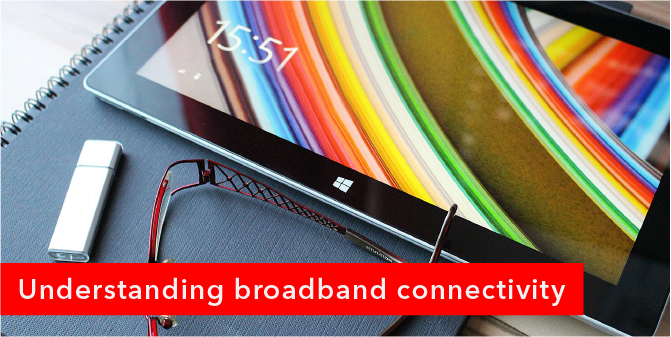Understanding broadband connectivity
‘Broadband’ is a term that is thrown around increasingly often. It is also a term that, to the untrained ear, can sound like just another ‘buzzword’ for the Internet. As easy as it is to just brush the term aside, stating that you understand the general meaning of the word; in today’s fast paced and constantly connected world, understanding what your Internet needs are and what options are available to you becomes more and more important. The need to know and understand what broadband is, and means, is becoming an increasingly relevant as new technologies continue to emerge and connectivity becomes more important at home, while travelling and in the office.
How Internet speed works
Internet speed is essentially measured in how much data can be sent to you as the user and it is usually measured at a per second rate. Bandwidth is the ability your device has to send and receive information. The more bandwidth you have available, the faster the data can be transferred to you. This however is only one side of the story as you will still experience ‘latency’ on your network.
The term ‘latency’ refers to delays in the processing of network data. For example, on a fibre network, data is transmitted at the speed of light which is tremendously fast. However even the smallest delay in that transmission, compounded over long distances, can be noticeable. In addition, the requested data rarely travels over one route to you and during its journey it will pass through multiple networks where bottlenecks can occur. This is particularly noticeable when accessing websites or servers internationally as, regardless of the speed of your connection, there is a minimum delay of +-160 milliseconds for the data to travel that distance.
Here is a list of common abbreviations used as the default measurement of a connection’s speed for the amount of data being sent per second:
- kbps – Kilobits per second
- mbps or Mbps – Megabits per second
- MBps – Megabytes per second
- gbps – Gigabits per second
Broadband connections
Internet connections generally come in two parts: the physical connection to the Internet and a data plan which provides the bandwidth you use. A simple analogy for this would be having a cellphone but also needing a call plan to make calls.
Types of broadband connections
As the need for Internet access has grown so have the types of Internet connections available to the home or business user.
Here is a list of some of the most common types of broadband connections:
- DSL – Digital Subscriber Lines (DSL) are the current standard for home connectivity and are still used by a large percentage of small to medium businesses. For this, your telephone line is upgraded to support DSL and, in combination with a broadband router, you have an ‘always-on’ Internet connection.
- Fibre – Fibre connectivity is a relatively new technology but it is being rapidly adopted both by home and business users as availability and cost effectiveness increases. Fibre connections are made over fibre cables which are thin glass tubes that transmit data as flashes of light.
- Mobile Wireless – Two of the most popular types of mobile broadband are 3G and LTE which utilize cellular networks to transmit data allowing access anywhere that your phone has signal.
DSL is the most common choice given its high availability, reasonable costs and speeds ranging from 1Mbps to 40Mbps. However with fibre becoming more available for both homes and businesses many users are upgrading to take advantage of speeds of between 100Mbps and 200Mbps. Where fibre and DSL are fixed connections, Mobile Wireless gives you the freedom to connect from virtually anywhere. RSAWEB also offers mobile connectivity solutions for both home or small business users and large businesses who need to manage multiple SIM cards and users.
Need help?
Our sales team is available to assist in identifying the right broadband solution for you or you can check out our website. If you would like to get in touch with our sales team you can email [email protected] or contact us on 087 470 0000.



